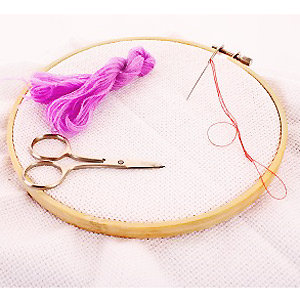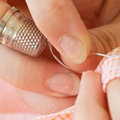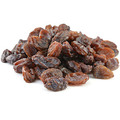Get started with embroidery
A complete beginner's guide to embroidery, with instructions for eight stitches too. By Kirsty Robertson

Embroidery is the art of using a needle and thread to embellish fabric with decorative stitches creating detailed designs.
The great thing about trying embroidery is that it’s very simple and doesn’t require expensive start-up materials, so it’s really easy to get started. It can be as easy or as complex as you want it to be and with just a few basic materials, tools and stitches you can create a wide variety of designs.
All you will need to start with is a few basic materials and tools.
Basic materials
Embroidery thread consists of six strands of thread that can be separated from each other to create finer stitches. Two to three strands are most commonly used. There is an extensive selection of colours readily available - Anchor or DMC 6 stranded cotton embroidery threads are widely stocked.
Fabric You can embroider onto lots of different woven fabric bases, but simple woven cotton or linen are the best choices to start with.
Basic tools
Embroidery hoop This holds your fabric taut keeping even tension across the fabric so that stitches are even. A basic hoop only costs a few pounds.
Embroidery needles These have large eyes to allow thicker threads. Buy a pack with various sizes so you can vary the amount of thread you use.
Scissors A small pair of sharp scissors are best to get a really close cut.
Design You can draw a design directly onto your fabric using a ‘disappearing ink’ pen or faint pencil. Alternatively, use a ‘heat transfer pencil’ to trace your design onto tracing paper and iron to transfer the design onto fabric. You can also buy iron-on transfers or trace existing designs from books/magazines/wallpaper etc. Ensure they are copyright free.
All the materials and tools mentioned above should be available in your local sewing and craft shops. You can also order all these items online.
Basic stitches
With eight basic embroidery stitches you can create endless designs. Click through to pages 2 and 3 for illustrated explanations of how to sew each stitch.
On page 2: chain stitch, stem stitch, back stitch, French knots
On page 3: blanket stitch, satin stitch, running stitch, lazy daisy
Three easy steps to follow
Prepare fabric:
Transfer chosen design onto right side of fabric.
Secure fabric in embroidery hoop by laying fabric right side up over the inner hoop and slip the outer hoop over the inner hoop, pulling the fabric evenly taut.
Tip: When you have finished working on the embroidery for the day, remove from the hoop so that it doesn’t leave a mark on the fabric.
Prepare needle and thread:
Two to three strands of cotton embroidery thread are most commonly used. Select your colour and thread needle.
Tip: Keep thread to a reasonable length to prevent knotting when stitching.
Begin stitching:
Stitch, following the transferred design using a variety of decorative stitches to create detail and texture
Easy ideas for beginners
To start with, keep it simple. For some beautiful but simple embroidery ideas to get you started try 'Sew an Indian elephant' and 'Create an embroidered picture'. You can also buy simple beginners embroidery kits with everything you need as a great way to start you off.
Once you've mastered the basic stitches you can embroider anything: clothes, bags, quilts etc. As you progress, you can move onto more advanced embroidery stitches and techniques, such as: cross-stitch, ribbon-embroidery and machine embroidery.
Get inspiration from...
Books:
'A Rainbow of Stitches: Embroidery & Cross-Stitch Basics Plus 1,00 Motifs & 80 Project Ideas' by Agnes Delage-Calvet
'Doodle Stitching: Fresh & Fun Embroidery for Beginners' by Aimee Ray
'Doodle Stitching: The Motif Collection' by Aimee Ray
'Sublime Stitching' by Jenny Hart
'The Embroidery Stitch Bible: over 200 Stitches Photographed with Easy-to-Follow charts'.
Classes
There are many embroidery classes running throughout the country. To find your nearest class search the internet. www.hotcourses.com lists classes in your area. Alternatively, ask at your local fabric or craft shop – they may even run classes themselves.
Shops
Local fabric, sewing and craft shops are good sources of supplies. Visit:
Hobbycraft (www.hobbycraft.co.uk) for everything you could possibly need
C&H Fabrics (www.candh.co.uk) for fabric, embroidery supplies & kits
John Lewis (www.johnlewis.com) for fabric and embroidery supplies
Websites
There are many websites selling embroidery supplies and kits so it is definitely worth having a search around for the best prices. Try:
www.sewandso.co.uk
www.stitcher.co.uk
www.cottonpatch.co.uk
www.barnyarns.co.uk
See the next two pages for how to do eight basic embroidery stitches
On page 1: chain stitch, stem stitch, back stitch, French knots
On page 2: blanket stitch, satin stitch, running stitch, lazy daisy










